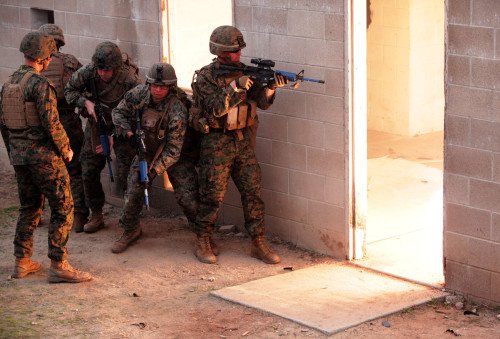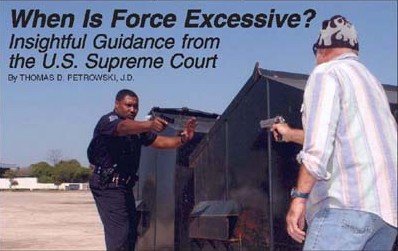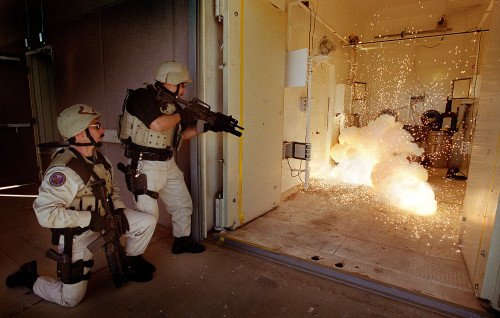The information presented in this article is for discussion purposes only. It is not legal advice no actions should be taken based on it. You should consult with your department’s legal counsel for guidance.
SURPRISE – is probably the most misunderstood component of this entire tactical philosophy. Defined as, “an unexpected or astonishing event, fact, or thing”, Surprise can be a very valuable ally to police tactical operations. Surprise can also be a very shifty and non-trustworthy companion, changing sides in a heartbeat.
EDITOR’S NOTE: This is Part II of a 3-part series on the widespread tactical training concept of “Speed, Surprise, and Violence of Action”. The training dogma has been overused to the point of ineffectiveness in certain situations. This part will focus on “Surprise” discussing the benefits and misperceptions this component involves. Part I discussed Speed, and Part III will discuss Violence of Action.
Surprise can be an action of stealth, but has more traditionally involved the introduction of distractions, in combination with speed, to overwhelm the senses of the hopefully unsuspecting criminals. These distractions, often called dilemmas in tactical training, typically involve the sudden breaching of doors or windows followed by the introduction of flash bangs, loud speakers, and/or blinding light sources.

As portrayed in the tactical dogma, surprise is a welcomed companion of the tactical team maneuver. Surprise acts with speed as a force multiplier if you will. The suspects are caught so off guard by the sudden police action, they are unable to react to the police officers presence, and can be quickly overcome and subdued because the officers moved so fast.
The fact is, SURPRISE can only legitimately be beneficial when the warrant is a no-knock (rare), or the action is dynamic due to the situation being a hostage rescue or active shooter response. In the later two, our presence is often already known so surprise through distractions and flash bangs is limited. Typically on search warrants the Courts have ruled officers must knock and announce their presence when serving search warrants, and provide the occupants reasonable time to surrender. This is not a set in stone time, as size of dwelling and time of day must be considered, but a general rule is 12-15 seconds.
If we are outside banging on the doors and windows, announcing “POLICE, SEARCH WARRANT”, how much surprise do you really think we have on the occupants inside? Rushing in on a “dynamic entry” after those conditions is reckless to the point of dereliction of duty to the officers involved. Everybody knows we’re there now, so wouldn’t it be better to breach and call-out? At least perform a threshold assessment, before rushing in.
However, just like I mentioned above in the SPEED section, police rarely have complete intelligence on a target location, or even targets. Without this critical information, officers making entry are often entering into the unknown, or worse – a best guess. Under these conditions, officers are experiencing SURPRISE just as much as the suspects inside, only in a different form. More importantly, the officers will continue to be confronted with surprise at every turn and in every room, where the suspects may nor may not be confronted with this dilemma – especially deeper into the structure.
Officers will ultimately be confronted with numerous unknowns. These unknowns tax the officers ability to process new information correctly. Each step in the residence creates a new OODA Loop, and officers can quickly be strained to the maximum. Officers senses are at the highest level of Condition Orange, and it is not too hard to understand why they could mistakenly enter Condition Red.
When making entries, whether in a tactical team or on the patrol level, officers are trained to prepare for the worse. This inevitably places the officers near the point of sensory overload. Only the most trained and experienced officers are capable of quickly processing all of the information and threats presented to them, and even they have limits. Training and experience cannot fully eliminate the enormous flood of information officers must sift through.

Speed, as mentioned before, can actually become a hinderance to the officer’s ability to process new information. Without an appreciation of this effect, officers continue to push hard, and we see too many 50/50 situations (officer and suspect see each other and fire at the same time), or worse, an officer that moves into an ambush location.
We as a profession also have to face the reality that there are many people who are not as impressed and effected by our techniques than we would like to think. With tens of thousands of gang members and hardened criminals who routinely face violence, our tactics are not going to be as effective. Should we face the unfortunate situation of a war veteran turned criminal or dangerous suicidal, their experiences in a combat zone are going to dramatically change their duration of effect from any dilemmas or surprises we try to present them with. There are also many people who have trained themselves in martial arts, mixed martial arts, UFC, etc. that are mentally prepared for the unexpected. All of these people will be much less “Surprised” by police tactics, and much quicker to respond in a defensive or offensive manner.
Caution on Flash Bangs
The use of multiple distractions (dilemmas) are often the preceding action prior to dynamic entry. In addition to the methods described above, the use of Flash, Sound, Diversionary Devices (FSDD), has become widely common among tactical teams as well. Don’t get me wrong, FSDD’s can be incredibly beneficial and effective, but they must be used correctly and wisely.
FSDD – often referred to as “flash bangs” – are Federally regulated explosive devices, that require extensive training to deploy properly. Using flash bangs on every warrant, or every barricade, is not only unwise, it can actually cross the threshold of reasonableness required by the 4th Amendment when making a seizure.

A recent case out of the U.S. 6th Circuit Court of Appeals (Krause v. Redford) upheld the use of FSDD as reasonable under the circumstances of that case, and did not violate the 4th Amendment. However, in the very same ruling the 6th Circuit referenced another case they heard (Bing v. City of Whitehall), where one of the uses of FSDD was determined to be in violation of the 4th Amendment.
Reading that case will turn your stomachs, because the “unlawful” FSDD deployment was just after the suspect fired on officers (after the initial call of him firing at children). Regardless of the facts, the 6th Circuit was not happy the FSDD was deployed when officers knew the suspect was near accelerants. The FSDD ignited a fire, which burned the suspect’s house down on top of him ending the threat.
Speed Without True Surprise is Just Speed!
Police and law enforcement tactical teams must be trained to understand the need to take their foot off of the accelerator. There is a time for speed, and there is a time to slow down. Failing to train this reality is negligent!
Oakland SWAT Killed on Dynamic Entry
In 2009, a murderer shot and killed a Oakland, CA Police traffic officer and seriously wounded his partner. At the stop scene he was armed with a handgun. He then fled the scene, and a massive manhunt began. The suspect was able to get back to his sister’s apartment and was hiding out. Tips came in about the location of the suspect.
Oakland SWAT responded to the apartment where the committed suspect was holed up. After talking to the sister, they finally determined he was likely inside, and in a particular room. Using “dynamic entry” the team members moved in. The suspect was hiding in a closet, and was now armed with an AK-47. The suspect was able to shoot three team members, killing two and seriously wounding one, before being killed by other team members.
Here is another classic example of the speed train leaving the station en route to a disastrous derailment. Once the Oakland officers had determined the location of the suspect, the most appropriate method of apprehension would have been “surround and call out“. This could have even been accomplished by maintaining a presence inside the apartment in a “limited penetration” plan. By controlling the suspect’s movements, negotiations could have begun for his surrender.
If the suspect refused to surrender or attempted to bring violence to the officers, the appropriate force options could be applied. Again, copious amounts of chemical agents, or even the deployment of a K-9, would likely change the suspect’s channels. Being barricaded in a bedroom leaves the suspect very vulnerable, and without food and water the suspect would eventually be unable to provide resistance.
Charging into the situation, only hours after the highly emotionally charged murder of the traffic officer, forces a confrontation when the suspect is still very much alert, aware, and aggressive. He knows his capture will mean a long term in prison, and he hasn’t had the time to consider whether living is the better option than dying. Forced into a confrontation, it is not at all surprising that the suspect chose to shoot it out again with officers.
Final Thoughts
Surprise is obviously a great benefit in the initial moments of any confrontation. However, the majority of search warrants or other police actions occur after our presence is known. Whether it is a knock-and-announce search warrant service or a barricaded subject situation, the fact is the suspect knows we are there. Police and tactical leaders must recognize the fact Surprise is likely completely gone once the police action initiates. In those type of circumstances the most prudent course of action is to make a threshold assessment, and then proceed with extreme caution using deliberate entry movements.
Law enforcement must realize that our tactics, our training, and our equipment is no guarantee of safety. No matter what we put on the outside, the mind is still our most powerful tool. Recognizing situations for what they are, and making critical decisions based on the reality we face, is the not only prudent but necessary. Police officers should not be dying and getting seriously injured on the false belief that we will always overwhelm our adversaries. It is up to Team Leaders and supervision to place the officers safety squarely above the suspects, and only allow their dynamic actions to violate that rule when the lives of hostages, victims, or innocent people dictate that we must.